Joe Brenner 41 Merc
JOE BRENNER 41 MERC
The Valley Custom Shop restyles the perfect mild custom 1941 Mercury 4-door Sedan for Joe Brenner.
This article was originally created in November, 2015, and more material was added in May, 2017 after we got in contact with Joe Brenner who supplied the Custom Car Chronicle with some very interesting never before seen photos and information about the history of the car.
The Valley Custom Shop restyled 1941 Mercury four door sedan for Joe Brenner has been one of my all time favorite mildly Customized four door sedans. This mildly restyled Mercury appeared in the February 1958 issue of Rod & Custom magazine, which happend to be among the first 10 copies of old R&C magazines I ever found. Those 10 magazines was all I had as far as old magazines and books for several years back in the late 1980’s. So every car inside those magazines is really special to me. But this 1941 Mercury would have most likely been very special to me no matter what. I just really like the wonderful simple lines of the stock 1941 Mercury, any body style, and especially after the Valley Custom Shop was finished with enhancing the beauty of it.

Everything about Joe’s Mercury is subtile, yet very stylish. Enhancing the already beautiful lines of the 1941 Mercury the Valley Custom Shop started with.
[divider]
For a long time this R&C article was the only thing I had ever found out about the car, as well as Joe Brenner. I had never seen any other photos of the car, not at any car shows, or in any private collections. While browsing the Getty Images The Enthusiast Network stock photo site I came across a series of photos of Joe’s Mercury I had never seen before. They clearly come from the R&C photo-shoot, taken at the same location, but they were never used in the final article. I have added them to this article. And some time after I added the photos Joe Brenner contacted us, and share some more info about the Mercury and the history on it.
 The February 1958 issue of Rod & Custom had a two page article on Joe’s Mercury. Apparently the car with a very 1940’s look and feel was still considered magazine material in 1958 when Customizing had become way more wild than we can see on Joe’s car.
The February 1958 issue of Rod & Custom had a two page article on Joe’s Mercury. Apparently the car with a very 1940’s look and feel was still considered magazine material in 1958 when Customizing had become way more wild than we can see on Joe’s car.
[divider]
1941 Mercury 4 door sedan
by Joe Brenner
I was always an extremely visual person. No matter if it was a car, a woman, or a banana, I always chose the best-looking one, the one most pleasing to my eyes, and then hoped all of their other traits and qualities equaled their appearance.
One day, a highschool chum and I were walking along a Burbank street looking at the passing cars. He asked which kind of car I liked. I confessed that none of them really turned me on. Just then a ’41 Merc sedan drove by. I was immediately struck by the look of its long pointy hood rising majestically between two symmetrical grills. (If I am not mistaken, ’41 Merc hoods are nine inches longer than ’41 Ford hoods). I loved the rounded look of the car’s back. And to my mind, those bumpers were the best looking bumpers ever made. Not too fat. Not too thin. They had a simplicity to them that was pure genius. As I was later to learn they were the last Ford car to have spring steel bumpers. And all of a Merc’s trim was made of stainless steel. I resolved then and there to get one.
I found a fairly bedraggled Merc in Santa Monica. It needed lots of work, anyhow I purchased it. Nothing special about it. Rag barrel interior. My parents approved as now, every day, I could take my siblings to school seven miles away.
 The R&C showed a small snapshot of the Mercury Joe had found in the used car lot. He paid $345.- for the car in 1951.
The R&C showed a small snapshot of the Mercury Joe had found in the used car lot. He paid $345.- for the car in 1951.
[divider]
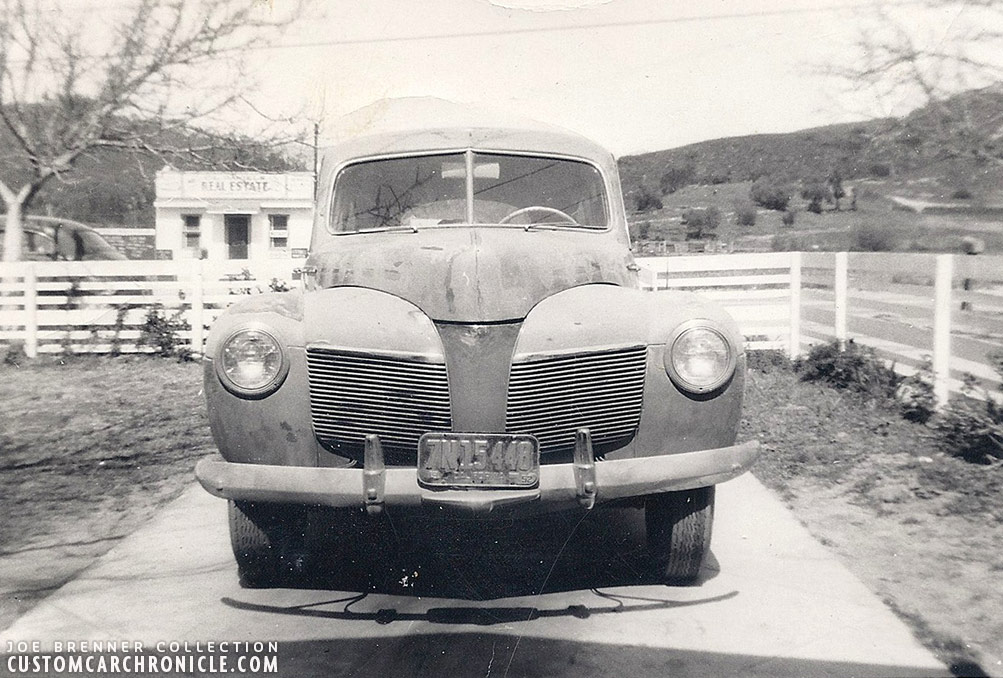 The Merc in the early stages with trim eliminated from the top of the hood and nose, and hood side strips in the process of being shortened.
The Merc in the early stages with trim eliminated from the top of the hood and nose, and hood side strips in the process of being shortened.
[divider]
 “White primer was once all the rage and here is a sample of that idiocy.”
“White primer was once all the rage and here is a sample of that idiocy.”
[divider]
 Then for a time, the Merc was covered in red oxide primer. Some other shop made a modest peak to the hood which flattened out as the peak ran aft. Also little peak, if any, on the nose piece.
Then for a time, the Merc was covered in red oxide primer. Some other shop made a modest peak to the hood which flattened out as the peak ran aft. Also little peak, if any, on the nose piece.
[divider]
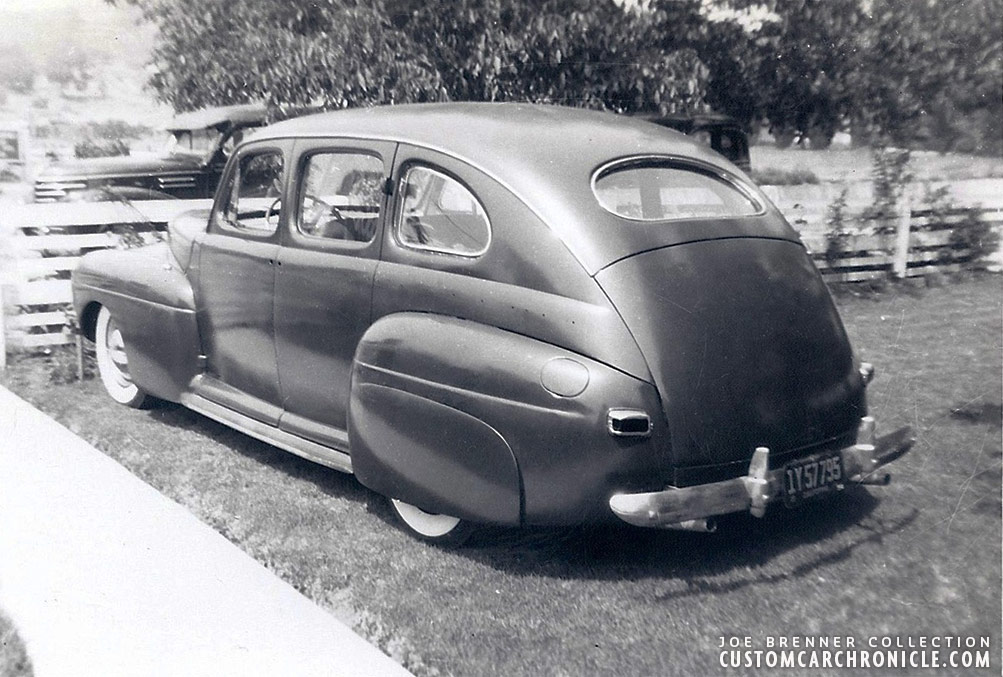 Truck was shaved,door handles removed and long skirts added.
Truck was shaved,door handles removed and long skirts added.
[divider]
Several years later, I wanted to build a hot flathead Merc engine. In the process of taking the heads off a junkyard engine, I managed to break 24 (Yes 24) studs off flush with the block. The busted off studs were so rusted in, an easyout couldn’t budge them. So having infinite patience, I drilled the largest hole I could into the center of each of the studs. Then with a tiny grindstone in an electric drill, I ground away all of the rest of the stud until I could see a fine black coiled line, the back side of the threads. Then using a pointed tool, the rest of the threads could be broken off piece by piece and the result was that i had a perfectly clean undamaged block once I ran the correct tap through it to clean up the threads.
I then sent the block out to C & T Automotive (Don Clark and Clem Tebow) in North Hollywood to have it bored out and a new crank and pistons installed. They bored the cylinders 30 thousanths of an inch over 3 3/8th inches and that coupled with a 4 1/8″ throw crank, made a 300 cubic inch flathead. (The original Merc engine was 239 cu in). Then with Edelbrock heads and manifold, three stromberg “48” carbs, and an Iskenderian camshaft, that engine was a screamer. Later on, after the Rod and Custom photoshoot, an overheat cracked the block and that was the end of that.
 Body work done and painted in ’54 Buick Titian red lacquer by Valley Custom. The longer front door molding strip was made possible by using the left remnant of the cut off hood strip. Where the original front door handle was, a small lockable glovebox door button protruded slightly to electrically open the door. Some of the Colgan black and white naugahyde interior is visible. I had removed the fender skirts by then.
Body work done and painted in ’54 Buick Titian red lacquer by Valley Custom. The longer front door molding strip was made possible by using the left remnant of the cut off hood strip. Where the original front door handle was, a small lockable glovebox door button protruded slightly to electrically open the door. Some of the Colgan black and white naugahyde interior is visible. I had removed the fender skirts by then.
[divider]
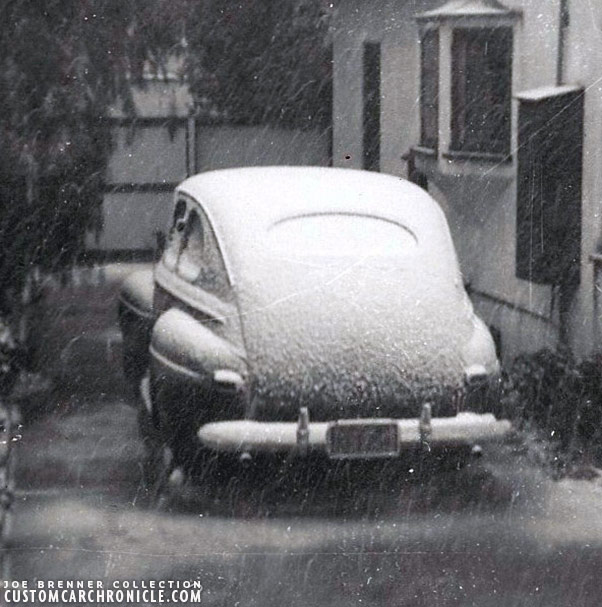 Taken in Tujunga CA during a rare snow shower, the snow piled up behind the rear bumper shows that the ’46 though ’48 Ford splash pan had already been added.
Taken in Tujunga CA during a rare snow shower, the snow piled up behind the rear bumper shows that the ’46 though ’48 Ford splash pan had already been added.
[divider]
Finished, just waiting for fun.
[divider]
The Merc was painted Titian Red, a ’54 Buick color. But Titian Red was a bleeder. It showed what was underneath. Buick primed their cars with red oxide primer which gave the finished car a root beer brown appearance. But my Merc was first painted with black lacquer, and the Titian Red put over it. It resulted in a most beautiful cherry maroon. It looked like later day Candy Apple red. And the Titian Red paint was very long lasting even sitting for years outside in the sun.
Soon after the Rod and Custom article, I installed a 283 Chevy Duntov engine in it with 12 to one compression, dual afb carbs, 4.44 gears in the differential. A stick shift 39 ford trans with Zepher gears.
Much to my temporary sorrow, I had to sell the Merc to pay for flying lessons. But, that eventually paid off handsomely, as I became a piiot for the Flying Tigers. During the last of my 30 year career. I was for 5 years a Boeing 747 captain. Flying around the world many times and to 50 countries, I have had more adventures than anyone should have. These adventures are recorded in my book THE MIGHTY TIGER.
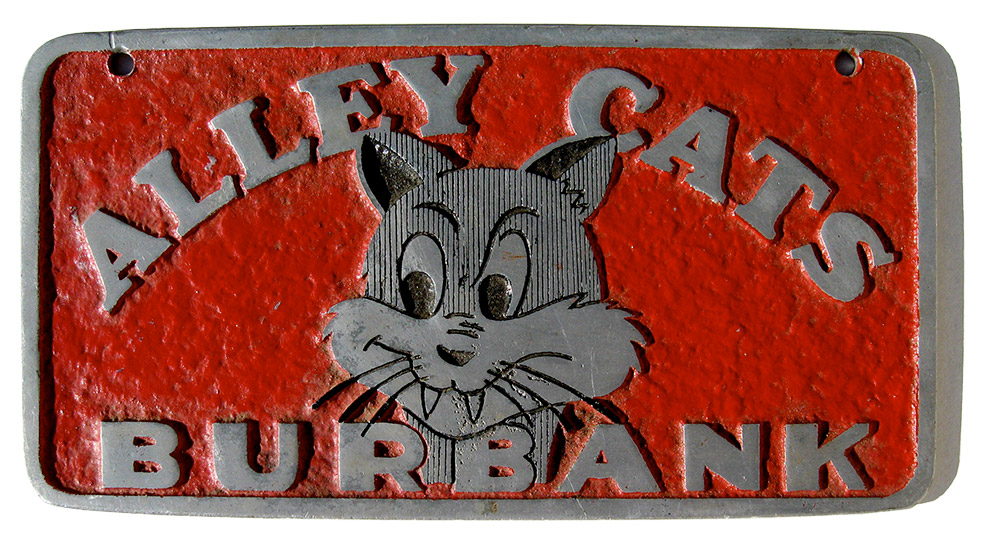 Joe saved the club plaque from the Alley Cat Burbank car club he was a member of . The plaque was hanging from rear bumper in the early years he had the Mercury.
Joe saved the club plaque from the Alley Cat Burbank car club he was a member of . The plaque was hanging from rear bumper in the early years he had the Mercury.
[divider]
The Restyling on the Mercury
The car was pretty rough when Joe found the car in 1951, but as we can read in Joe’s story, he loved the over all shape of the car. A plan was made for the restyling and he ended up choosing the Valley Custom Shop in Burbank, California to perform the restyling, since he had a job at the shop at the time. The restyling planned was very subtile, and would enhance the already very nice body lines. The frame was modified in the rear and a Valley Custom lowering kit was used to drop the body with a slight speed-boat stance.
The door handles were removed and the side trim modified since the door handles are part of the side trim on the 1941 Mercury models. The trim on the hood was shortened and the center hood trim removed all together. The two hood sides were welded to a single unit and a wonderful peak was added to replace the trim. The lower hood trim and the piece between the two grille halves was shaved and smoothed. Then a set of 1952-54 Mercury headlights was molded into the front fender. The parking light were obviously also shaved which all resulted in a very smooth front end.
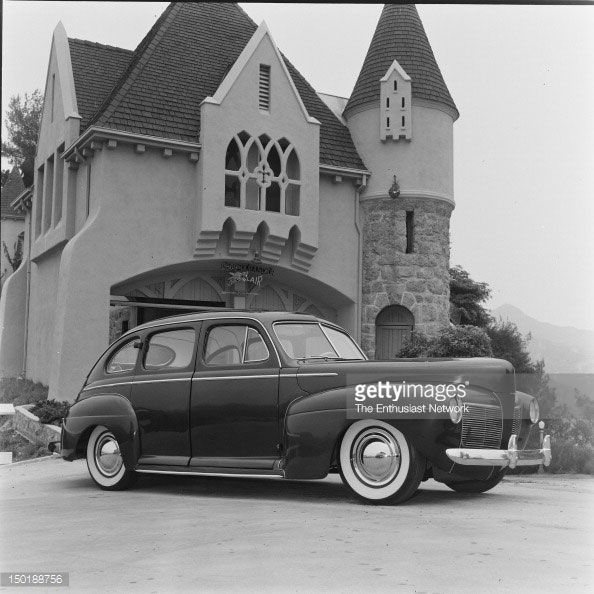 Low angle photo shows the nice stance of the Mercury. This is one of the images that made it into the R&C article. (Photo by Fred Beindorff courtesy of Getty Images / The Enthusiast Network)
Low angle photo shows the nice stance of the Mercury. This is one of the images that made it into the R&C article. (Photo by Fred Beindorff courtesy of Getty Images / The Enthusiast Network)
[divider]
 (Photo by Fred Beindorff courtesy of Getty Images / The Enthusiast Network)
(Photo by Fred Beindorff courtesy of Getty Images / The Enthusiast Network)
[divider]
 Another photo that made it in the R&C article (Photo by Fred Beindorff courtesy of Getty Images / The Enthusiast Network)
Another photo that made it in the R&C article (Photo by Fred Beindorff courtesy of Getty Images / The Enthusiast Network)
[divider]
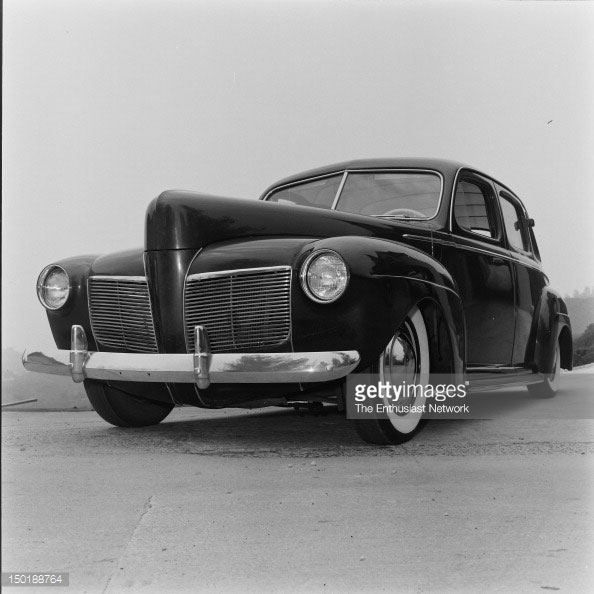 This low angle photo gives us a good look at the nice subtile peak on the hood. It also shows the slight Speed-Boat stance of the car. (Photo by Fred Beindorff courtesy of Getty Images / The Enthusiast Network)
This low angle photo gives us a good look at the nice subtile peak on the hood. It also shows the slight Speed-Boat stance of the car. (Photo by Fred Beindorff courtesy of Getty Images / The Enthusiast Network)
[divider]
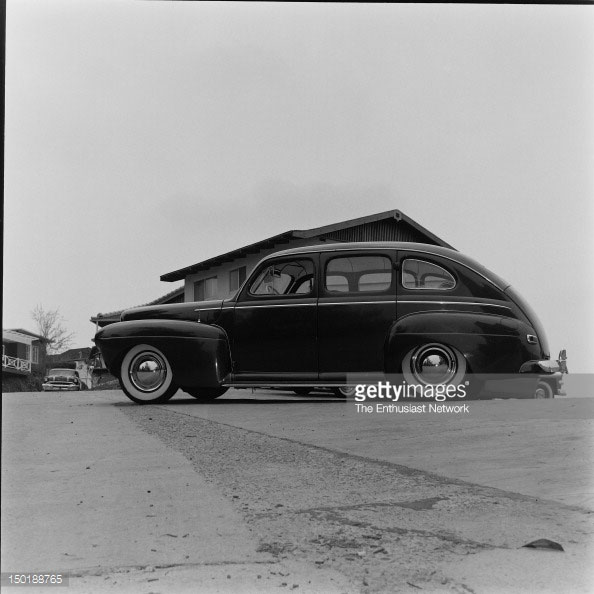 Here we can see the stance even better and we can see the 1946-48 rear splash pan that was added. (Photo by Fred Beindorff courtesy of Getty Images / The Enthusiast Network)
Here we can see the stance even better and we can see the 1946-48 rear splash pan that was added. (Photo by Fred Beindorff courtesy of Getty Images / The Enthusiast Network)
[divider]
 (Photo by Fred Beindorff courtesy of Getty Images / The Enthusiast Network)
(Photo by Fred Beindorff courtesy of Getty Images / The Enthusiast Network)
[divider]
At the rear the trunk was completely shaved and an 1946-48 splash pan added. On all four fenders the trim pieces were shaved, but the running board trim stayed. The team also choose to ad a accessory chrome trim piece for the drip rail accentuating the shape of the roof. But the wider stainless trim around the windows was removed and all holes filled and smoothed. With all the body work done the car was painted, only we do not know what color this was. The R&C article does not mention anything about the color, so all we know is that it was a super glossy dark color. A set of whitewalls was mounted and the wheels were dressed up with a set of ribbed moon aftermarket hubcaps. These hubcaps can be seen on quite a few Customs rolling out of the Valley Custom Shop.
 The interior was done very nicely in a late 1940’s style, nice rounded shapes with full tuck & roll panels in black and white Naugahyde upholstery which was done by Colgan’s Auto Upholstery on Magnolia, in Burbank. (from the R&C article)
The interior was done very nicely in a late 1940’s style, nice rounded shapes with full tuck & roll panels in black and white Naugahyde upholstery which was done by Colgan’s Auto Upholstery on Magnolia, in Burbank. (from the R&C article)
[divider]
The engine was updated with several speed components and the interior was done in a wonderful two tone tuck & roll with light colored piping matching headliner in the light color with dark piping. The whole interior is done in a very nice 1940’s style, which fit the car very good, but which also is perhaps a bit outdated in 1958 when the car was “finished”. This, and many other things on the car show that Joe Brenner wanted to restyle his 1941 Mercury to make it look better, not to score points at the Custom Car shows. All the modifications done on the mercury are to enhance the shape of the car, and the team has really succeeded in this.
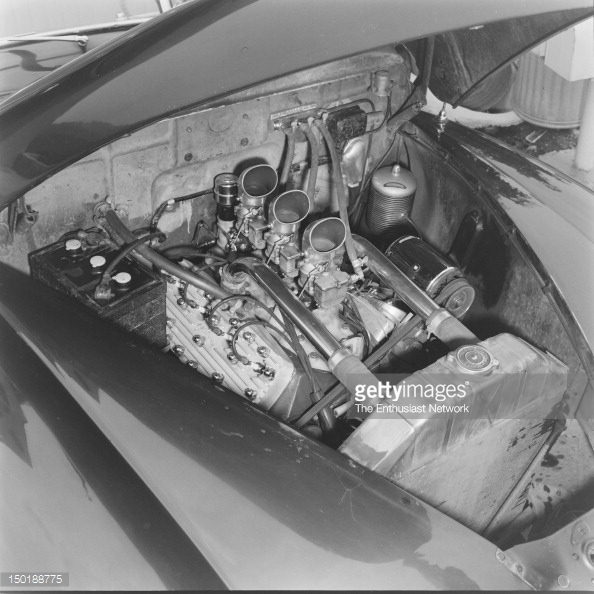 The Merc’s 300 cu in flathead with three Stromberg “48” carbs, and a dual coil Lincoln V-12 distributor. Note the rare Filcoolater A-4 finned accessory oil filter/cooler mounted on the firewall. “Around that time one of fads young drivers used to show off the prowess of their cars was to zoom up Fargo Street in Los Angeles. Fargo Street had a 32% grade making one of the steepest streets in the nation. From a sanding start, I sped up that street and reached the top at 30mph (helped by the Merc’s 4.44 rear end gears), and immediately slammed on the brakes, as just over the top was a cross road and if you didn’t slow enough to turn left or right, straight ahead was a precipitous drop. Today Fargo Street has been bisected by a cross road a quarter of the way up, so Fargo is no longer the source of bragging rights it once was.” (Photo by Fred Beindorff courtesy of Getty Images / The Enthusiast Network)
The Merc’s 300 cu in flathead with three Stromberg “48” carbs, and a dual coil Lincoln V-12 distributor. Note the rare Filcoolater A-4 finned accessory oil filter/cooler mounted on the firewall. “Around that time one of fads young drivers used to show off the prowess of their cars was to zoom up Fargo Street in Los Angeles. Fargo Street had a 32% grade making one of the steepest streets in the nation. From a sanding start, I sped up that street and reached the top at 30mph (helped by the Merc’s 4.44 rear end gears), and immediately slammed on the brakes, as just over the top was a cross road and if you didn’t slow enough to turn left or right, straight ahead was a precipitous drop. Today Fargo Street has been bisected by a cross road a quarter of the way up, so Fargo is no longer the source of bragging rights it once was.” (Photo by Fred Beindorff courtesy of Getty Images / The Enthusiast Network)
[divider]
 A better shot showing the improved hood and nose peak redone by Valley Custom. The peak now ran all the way back to the windshield and was also all the way down the nose. (Photo by Fred Beindorff courtesy of Getty Images / The Enthusiast Network)
A better shot showing the improved hood and nose peak redone by Valley Custom. The peak now ran all the way back to the windshield and was also all the way down the nose. (Photo by Fred Beindorff courtesy of Getty Images / The Enthusiast Network)
[divider]
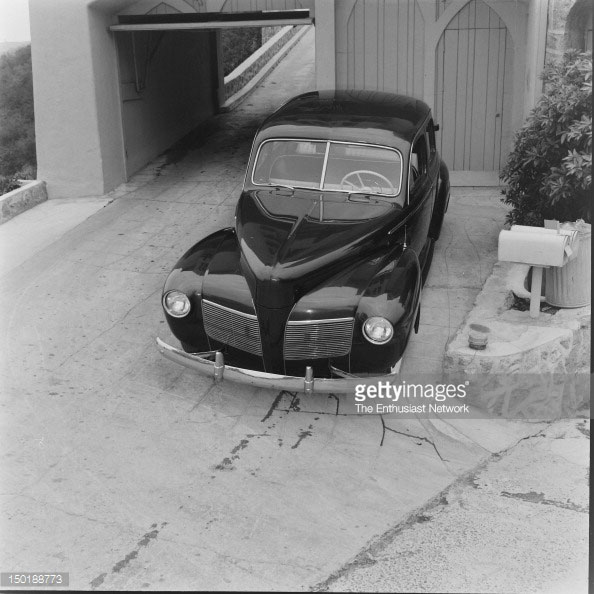 Birds-eye point of view shows the hood peak really well. (Photo by Fred Beindorff courtesy of Getty Images / The Enthusiast Network)
Birds-eye point of view shows the hood peak really well. (Photo by Fred Beindorff courtesy of Getty Images / The Enthusiast Network)
[divider]
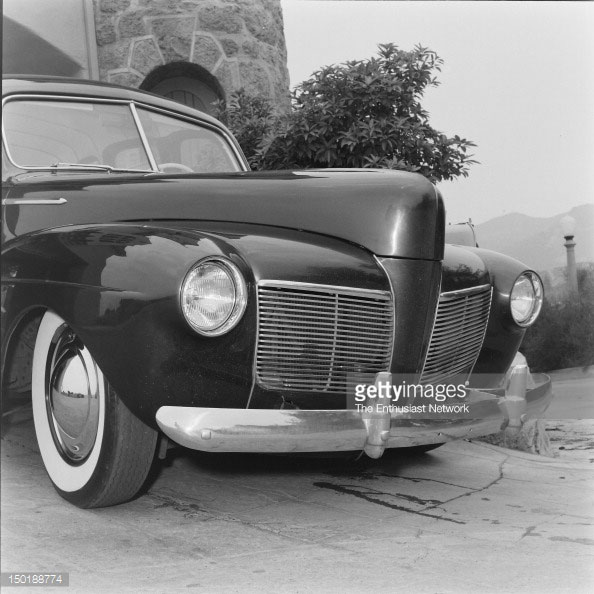 1952-54 Mercury headlights were nicely molded into the front fenders. (Photo by Fred Beindorff courtesy of Getty Images / The Enthusiast Network)
1952-54 Mercury headlights were nicely molded into the front fenders. (Photo by Fred Beindorff courtesy of Getty Images / The Enthusiast Network)
[divider]
Joe’s 1941 Mercury shows that 4-door models can be used very well as a base for a Custom Cars. With the right amount of restyling these cars can become really beautiful Customs. The same also goes for the 1941 Mercury in general. Not to many Customs have been based on this years Mercury, even though a few, including Joe’s car show how absolutely wonderful they can look with the right amount of restyling.
[divider]
The Mighty Tiger
Joe Brennen later wrote a boot about his 5 years as a Boeing 747 captain. Flying around the world many times and to 50 countries. He had had more adventures than anyone should have. These adventures are recorded in his book The Mighty Tiger (published 2003) And included in the book are some stories about the Mercury and related material.
Below are some excerpts from the book.
[box_light]
“About the only usable asset I seemed to have was that I have always loved machinery. I especially loved cars from my earliest days, as they were the one form of machinery most accessible to me. So, as I grew up, I had my share of hot rods and custom cars with high performance engines. And, as I also had some talent for improving cars, both operationally and esthetically, I leaned toward being an automobile designer.
“However, that bubble burst while taking a high school drafting class when it dawned on me that I’d have to forsake the beaches and bathing beauties of sunny Southern California and instead live in sooty, snowbound Detroit with its darlings bundled up from head to foot against the deathly cold. Besides, it’d be just my luck not to be among the exalted few who got to design sleek, high-powered sports cars. More likely, I’d be assigned routine tasks like engineering the back side of glove compartment doors for frumpy station wagons. Luckily, my aspirations for a life as a Detroit auto designer died a natural death before I wasted time finding out that wasn’t what I really wanted in the long run.
“My interest then tilted toward the auto customizing business, which was prevalent especially in Southern California at the time. Fresh out of high school, I was employed in 1952 by two of the best customizing artisans in the business, Neil Emory and Clayton Jensen, at their Valley Custom shop in Burbank. But, there, too, in the customizing field, were warning signs on the horizon for those who had their eyes open. More and more, Detroit offered consumers cars that rivaled the best work of any custom shop, and often for less money. I mean (using the 1953 Mercury for example), you could buy right off the showroom floor a chopped and channeled stock car with tuck-and-roll naugahyde upholstery. A year later, the Mercury had an overhead valve engine.
“As the months passed, I came to think that, except for a few diehards, the auto customizing business faced a downward spiraling future, at least for the foreseeable future. Emory and Jensen shared the same opinion and folded shop to enter the collision repair business because insurance companies had more money, plus they paid on time.
“(However, our vision was terribly shortsighted. The car modification industry endured a slump of only a dozen years or so. But when the current generation of baby boomers matured, they emerged far richer than their parents were thirty years before. Their abundant discretionary wealth gave rise to a tremendous resurgence of interest in the motor vehicle. As a consequence, the motoring world became extremely lucrative as money was lavished on all sorts of custom cars, hot rods, motorcycles, restorations, monster trucks, etc.)
“I was still hooked on cars, but not into restoration. For in restoring cars, a car is either restored authentically or it is nothing. But, if a car is restored accurately, there is no room for self-expression; you are merely refurbishing someone else’s design. It was the ability to express my own tastes and individuality through departure from the slavish constraints of established designs that I valued more than the mere work of shaping and painting metal or the revamping of things mechanical.
“This ability for design enhancement surfaced in my hobby of building dozens of model cars. One of my creations was an especially good-looking futuristic model pickup truck which I dreamed up at the last minute. I thought it good enough to enter in a national contest whose deadline for entries was mere days away. I worked on it feverishly every waking moment and had it about done as the entry deadline approached, when my wife started to raise a ruckus about my being up late and working on another of those “stupid little cars.” Finally, to end her shouting (which was surely keeping our apartment house neighbors awake), I put my tools and paints away, and went to bed. As a consequence, I entered my model in the contest the next day without having added anything to its interior.
“Well, I took second place and received a huge trophy. One of the national contest judges told me afterwards that the car that won, which he described as exhibiting “good craftsmanship, but uninspired design,” won first prize, not for meritorious design, but by dint of points alone. And, it had beaten my entry out by only one point—one lousy point! The judge told me that had I even put a steering wheel or a seat in my truck, it would have taken first prize. That “stupid little car” would have earned me a thousand-dollar first prize, plus a college scholarship.”
“Another consequence of that national contest was that the leading manufacturer of model car kits saw my extraordinary little truck in the contest and thought enough of it to offer me a job designing model cars for their firm. I decided, however, that it was time to quit playing with toys, so I declined their generous offer. By now I knew that what I really wanted was to be associated with the real thing. I loved to operate machinery. I loved big. And, the bigger, the more powerful the machinery, the better.” . . .
So, I became a pilot.— Eventually, toward the end of my thirty-year career, for five years I flew as captain of the 820,000 lb. Boeing 747 to fifty countries all around the world.
[/box_light]

Joe also send us a picture and a cool story of another car he owned. A ’67 Corvette, not really a Custom Car, but the story is too good not to tell
[box_light]
Joe Brenner ’67 Corvette
Here is another car I owned, a ’67 350hp, 327 cu. in. Corvette, that is exceptional for two reasons:
It was ordered new without emblems.
It took top eliminator in both the small block and big block classes on the same day at Lions Long beach CA drag strip. (note the 2 foot tall trophy standing on the back of the hood.)
Having worked at Valley Custom, I especially disliked the chrome warts that disfigured, and took away from, the beauty of a car’s design. So, it said on my original purchase order from Baher Chevrolet “No emblems.” That’s the way I ordered it. That’s the way I received it.
With the intention of owning a true sports cars, I ordered my Corvette without power steering or air conditioning.
When I picked up the car, it had a terrible stance. It stood at least two inches higher in front than in the back. It looked like a motor boat, so I had one size smaller tires put on the front, and larger wider tires put on the back. The result was the car now sat level.
’67 Corvettes originally had tires with a measly 6” wide tread. But with those wider tires, even with its Muncie trans and positraction, the car now wouldn’t lay rubber. But oh man, if it got a grip on the pavement, it would launch with neck snapping ferocity.
The picture taken at the drags shows the car mid-customizing, true knockoffs, a 427 hood, and a ’65 grille, and rocker panels. Inside, all the plastic dash knobs had been replaced with earlier Corvette all metal chrome knobs.
When I first got my Corvette, I was really disappointed by its performance. In the first month I owned it, I had it in three different Chevrolet agencies trying to get its lack luster performance increased, also its poor 15mpg fuel consumption improved.
One thing that really peeved me was the dash pot put on the carb to prevent you from quickly closing the throttle plates in the carb. If you let your foot suddenly off the gas pedal, that dash pot sped the engine up and brought it slowly back to a lower rpm. My favorite thing was come racing up to a stop sign, with the trans jammed in a lower gear, let my foot off the gas pedal, and slow down on compression.
Finally, the last Chevy tech said “Son, it’s an engineering booboo. The engineers have installed a smog device on a performance engine that wasn’t designed for it. Your engine is right on spec. You’ll just have to live with it.”
But when a friend showed me his ’67 Vette first registered in CA, (by some fluke,) had only a positive crankcase hose, I took all the smog devices off my car and threw them into a cardboard box. Then I installed a set of Hooker headers, but because headers make an engine run lean, I had to go two sizes richer on the main jets.
Next, I took the car over to Doug at Doug’s Corvettes, in North Hollywood. And, could Doug ever super-tune a car! He changed the ignition advance, and also the total timing.
Man, now that car screamed! Plus the gas mileage jumped up to a consistent 20mpg. So much for the benefits of CA smog.
When the last of the 100 octane leaded gas was coming down the pipeline, I took my Corvette to the Lions drag strip in Long Beach. When I pulled up to the starting line, I told the starter that all I wanted to do was make a couple of runs by myself so I could get a timing slip.
“Haven’t got time to fool with you. We’re running a race here. You’ll have to run off against the small block next to you. Whoever wins the heat gets the timing slip.”
So, I got on it pretty hard. Beat that guy, and kept going back perfecting my technique, beating one car after another. And don’t you know out of a field of over 30 small blocks, I took top eliminator!
Going over to the winner’s circle to get my trophy, the official told me, “Yeah, you won your class all right, but we’re short of trophies today so we’re giving the trophy to the big block winner, because he’s the winner out of 12 big block Corvettes, and going 10 mph faster than you.”
“Like hell,” I exclaimed. “He’ll have to race me for that trophy.”
So, they got us up to the starting line, and when the light turned green, I was off like a shot. I never saw the big block beside me during whole the quarter mile run, but only as I approached the finish line, I saw him coming up fast, but I beat him across the line by 10 feet. Were the strip 50 feet longer, he would have thundered past me, but I got there first.
Was that big block driver ever mad! I went home with the trophy. Top eliminator in both the small block and big block classes. Same day! How many people do you know that can make that claim?
I originally paid $4,335 for the Vette, and later sold it for $20,000. I think it went to somewhere in Texas to a county that doesn’t have smog checks. If so, that new owner is a happy camper.
![]()

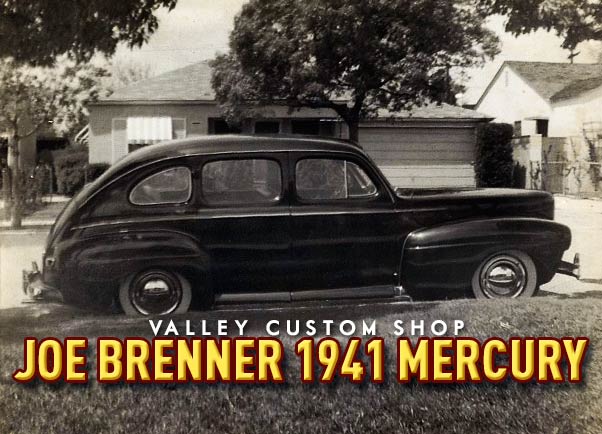




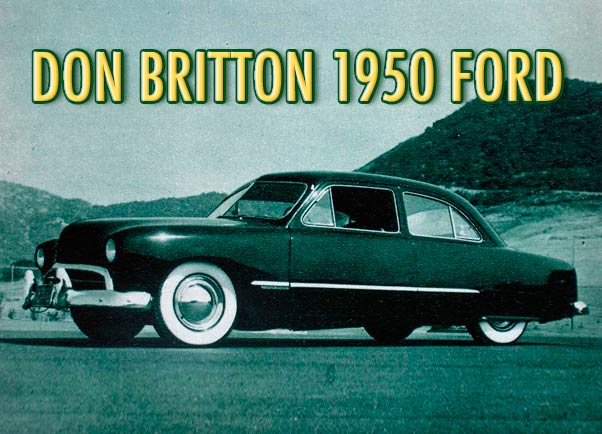

In so many subtle ways, Neil Emory and Clay Jensen were able to take a basically sound shape of a car and refine it. This car has so many of those touches, cleaning it of unnecessary and even distracting Detroit glitz, and then contributing such fine improvements like that peak in the hood, dropping down between those beautiful paired grilles. Thanks again, Rik, for taking us all back, and pointing out those magical Valley Custom touches.
WHAT A NEAT MERC AWSEOME, GOOD ARTICLE RIK, AN WELL SAID LARRY POINTER, HI LARRY,
Larry did say it very well. I too have that issue of R&C and admired this sedan for it’s basic beauty. I have always been a fan of frenched head lamps on the early customs, rather than the later frenched and tunnelled style which came along with the 50s models.. This car proved me dead wrong as those lamps look perfect on that front end! Another sublimely styled custom from the Valley Custom shop!
Thanks Rik!
Dave
Great article Rik made even better by the added back story on the Mercs transformation. Shows the nay- sayers that a 4 door can be turned into a beautiful custom.
Torchie
What an interesting read…I like his line about finding the best-looking one, whether it’s a woman, a car, or a banana. That really sums up about half of my interest in kustom cars right off the bat.
This car really makes you give sedans a second look and it could hold its own around a number of two doors. My wife is nuts about ’40s Ford four door sedans and when I think of this car, all rules against owning a door slammer change.
Pretty neat to see how selling his beloved kustom launched a fascinating career.
BTW, here’s more info on the R&C photo shoot location:
http://mansion-homes.com/dream/the-infamous-wolfs-lair-castle/
Great to revisit this article with the updates. Mr. Brenner’s book appears like an interesting read as well.
Dave
I always loved the pictures of Joe’s ’41 Merc sedan in that early issue of Rod and Custom. Clean lines, great stance and quality bodywork from Valley Custom made it beautiful! My first car was a ’41 Merc, so I guess this sedan might have had an influence on me.
Hi Rik: From Joe Brenner owner of the 4-door Mercury you featured.
As a matter of interest, the Merc was first painted with black lacquer, then over the top of that 1954 Buick Titian red. It resulted in a beautiful cherry maroon.
Titian red was a bleeder. It showed what was underneath. A stock 54 Buick painted Titian red, looked root beer brown because Buick used a red oxide primer underneath.